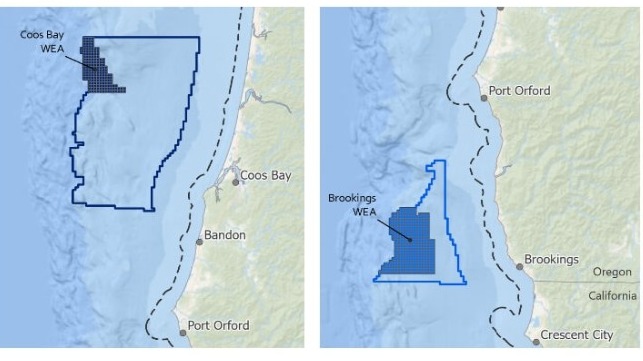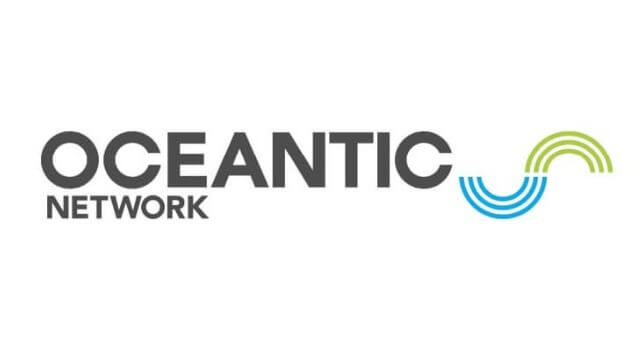BOEM Approves Controversial Wind Energy Areas off Oregon

After a months-long process of engagement with local fishermen and tribes, the Bureau of Ocean Energy Management (BOEM) has designated two final Wind Energy Areas off the Oregon Coast. Despite local opposition and skepticism from fisheries stakeholders, the areas will still go forward in BOEM's planning process, but will be 11 percent smaller.
BOEM's initial draft wind areas announced in August 2023 would have allowed the development of about 220,000 acres off Brookings and Coos Bay, with power generation potential of about 2.6 GW. After months of stakeholder meetings, held at the request of the state's governor and both of its senators, the revised final areas cover about 195,000 acres - about 11 percent smaller than the draft - and have about 2.4 GW of generation potential. The physical locations and distances from shore are comparable to the draft areas.
The final result drew scathing criticism from the local fishing industry. Heather Mann, executive director of the Coos Bay-based Midwater Trawlers Cooperative, called BOEM's engagement process "a slap in the face to Oregon’s coastal communities."
"The final wind energy areas are slightly different from the draft wind energy areas produced earlier this year, but certainly not an acceptable or meaningful response to the many concerns including those raised by tribes, fishermen, marine scientists, environmentalists, and state and federal legislators," said Mann.
The local tribal council said that they had learned of BOEM's decision from the state governor's office, and hadn't gotten a phone call or other advance notice from the federal agency.
"BOEM’s press release states that it has ‘engaged’ with the tribe, but that engagement has amounted to listening to the tribe’s concerns and ignoring them and providing promises that they may be dealt with at some later stage," said Tribal Council Chair Brad Kneaper. "The tribe will not stand by while a project is developed that causes it more harm than good – this is simply green colonialism."
The effects of wind farm development on the unique oceanography of the California and Oregon coastline is not yet fully understood. The California Current, a wind-driven coastal upwelling, draws up nutrient-rich water from the depths. This drives phytoplankton blooms, which feed the rest of the food chain and underpin abundant fisheries. Early studies and simulations suggest that wind velocity reductions from an offshore wind farm could have complex effects on coastal upwelling, though more research will be needed to determine the full impact. In a 2022 study, the Oregon Department of Energy cautioned that floating offshore wind development "could cause changes in oceanography and atmospheric conditions . . . and affect coastal upwelling."
Unknowns like these are concerning for the area's tribal council, and are particularly troubling to the local fishing industry. The federally-designated Pacific Fishery Management Council has also called on BOEM to rescind its offshore wind plans and start the development process over again, citing "significant friction with coastal communities, the fishing industry, and Tribal governments."
Now that it has completed designation of the final Wind Energy Areas (WEAs), BOEM will conduct a 30-day scoping period to solicit comments on how to conduct an environmental impact study of the now-finalized WEAs.
BOEM's regulatory activities do not guarantee a timeline for commercial development. The U.S. East Coast offshore wind industry has encountered setbacks due to high interest rates and supply chain delays, which have raised costs. Development on the U.S. West Coast will be even more costly, because the region's deep water will require floating offshore wind platforms and moorings. This new technology is entering maturity, but is expected to be substantially more expensive to build and install.
"Offshore wind is likely to play an important role in meeting our state’s growing energy demand and goal of 100% renewable energy by 2040," Oregon Governor Tina Kotek said in a statement. "It also presents a significant economic development opportunity for the Oregon coast. As BOEM moves forward with establishing a federal offshore wind leasing process this year, Oregon is committed to developing a robust and transparent state roadmap to inform offshore wind opportunities."
Finalists Announced For New Maryland Offshore Wind Program

Oceantic Network concluded the Maryland Offshore Wind Forum today, by announcing the first cohort of companies, comprised of nine Maryland businesses, selected to participate in the Maryland Offshore Wind Market Entry Coaching program.
The Market Entry Coaching program is a new initiative, sponsored by the Maryland Energy Administration (MEA), created to help Maryland-based businesses, particularly minority or women-owned businesses (MBEs/WBEs), enter or expand their work in the U.S. offshore wind industry as well as other related ocean renewables industries. Selected companies (full list below) will receive customized consulting services to develop a market entry strategy or business plan. The Network is working with Pelergy, an onshore and offshore wind energy business and innovation firm specializing in strategic approaches to project development and operations, to deliver consulting services. The following nine organizations were selected as the first cohort, with the following MBEs/WBEs italicized:
- ACTIVEcharge
- Baron Resources, LLC
- Blackwater Environmental Group
- Estime Enterprises, Inc.
- Mighty Waves Energy
- nTech Workforce
- SHE3CAP, LLC
- SpatialGIS
- SURVICE Engineering
“For over a decade, the vision of offering companies access to offshore wind global market experts has been close to my heart, and seeing it come to fruition is nothing short of exhilarating,” said Liz Burdock, founder and CEO of Oceantic Network. “The Maryland Offshore Wind Market Entry Coaching initiative, generously supported by the Maryland Energy Administration (MEA) empowers Maryland-based businesses— especially small businesses—by providing them with a market expert to develop a business plan tailored to both domestic and international offshore wind markets. This is a competitive advantage companies in other states do not have and prepares Maryland businesses for success.”
Also at the Forum, attendees discussed a new bill recently introduced to Maryland’s legislature (HB 1296) to bolster the state’s offshore wind industry. Among other provisions, the bill would require the state’s Public Service Commission (PSC) to open an expedited offshore wind renewable energy credit proceeding for revised bids on June 1. It also requires the state to develop a plan for achieving a total of 8.5 GW of offshore wind energy by 2031 and submit it to the General Assembly by January 1, 2025.
Over 100 stakeholders attended the conference including representatives from offshore wind developers such as Equinor, RWE, Orsted, and US Wind; supply chain companies such as Arcon Welding, Crystal Steel and Strum Contracting; Government agencies including the US Bureau of Ocean and Energy Management, Maryland Public Service Commission, Maryland Department of Labor, Governor’s Office of Small, Minority & Business Affairs, and Baltimore County’s Office of Economic Development; labor unions, and environmental advocates.
The products and services herein described in this press release are not endorsed by The Maritime Executive.
No comments:
Post a Comment